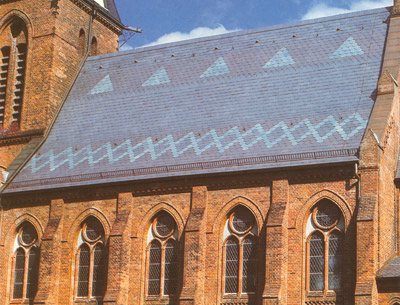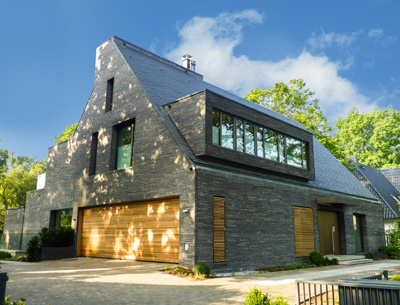A Slate Roof – a Wonderful Piece of Nature
The winning points of a slate roof:

Slate belongs to the oldest roofing materials altogether
Many historically impressing buildings, as we know today from archaeological finds, had slate roofs already in Roman times.
Slate is a completely natural building material, produced from sediments of prehistoric oceans some 400 million years ago. It is easily to be split into thin even slabs along a splittable surface.
Slate roofs are natural roofs with unique properties: no harmful substances evade and they are resistant to acid rain and atmospheric pollution. Slate is regarded as the longest lasting roofing material and when properly chosen and installed it can be the most durable part of a building. With the best types of slate a durability of 250 years and more has been proved. Some special types of slate can even be reused for restoration work. Thus slate gives excellent long-term value.
Slate also for modern buildings
Slate, in former times considered a regional roofing material, has left its traditional regions and is now being requested by regions in which up to then it was not customary.
The attraction of slate is not only its ecological value but particularly its adaptability.
It offers a wide variety of structural applications, contributing to the beauty of any building. On modern buildings as well as on venerable churches, castles and other historical monuments a slate roof is an especially aesthetic sight.
Slate can be used on nearly all sloping roofs. Valleys, junctions and corners can be formed from slate, too, giving the roof a neat appearance and making it look as a “unified whole”.


Slate roofing – great variety of structural applications and individual solutions
Different colours, shapes, sizes and textures afford many architectural effects. In order to give the building a special character the owner can choose between different kinds of slate roofing, e.g. the “Altdeutsche Deckung”*, the “Schuppendeckung”*, the “Bogenschnittdeckung”*, the “Rechteckdoppeldeckung”*, all of these with a variety of slate, furthermore the “Spitzwinkeldeckung”, the “Wilde Deckung”* or other slate roofings.
As far as colours are concerned there are also different possibilities. Depending on the different countries of origin such as Germany, Wales, England, Spain, Canada, the USA and Brazil, slates are to be found in the colours bluegrey, green, purple and mottled green and purple.
And not forgetting the eye catching slate ornaments with which roofs, façades or chimneys can be decorated, thus allowing the owner to give his building an individual touch.
Slate roofing – carried out by experts, good value, ecological
Unfortunately, there are still many roofs containing asbestos presenting a danger for health and environment. As the difference in price between natural slate and asbestos-free imitated slate nowadays is negligible, most of the roofs are being restorated with natural slate. In the spirit of preservation of buildings, façades, dormers, gables, chimneys and attics are therefore often restorated with slate at a later stage.
Already centuries ago slate became famous mainly through the high level of German craftsmanship. This has not changed up to now. Though complying with building regulations, each slater has his own personal style thus creating an artistically unique specimen. Many slates are still cut manually on site. The slater is a craftsman who gives his own form to his work and who, after basic training, needs long years of experience to become perfect. Slate is a material for experts.
For this reason it is important to have slate roofing done by an especially trained expert.
* Please find the translation/explanation of the different ways of slate roofing under “Ways of Slating“.
